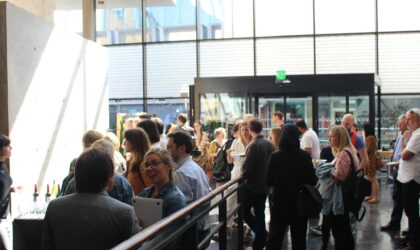
Beginner Read Audience Data Collection and Evaluation
Audience research is the process of gathering information about the people who visit you or see your work, use your services, or engage with your organisation.
In this article
In our ever-growing digital landscape, creating content for people with a wide variety of access needs has pushed accessibility to the forefront of our online activities.
In terms of presentations, videos, training sessions, and public speaking, an easy thing to start doing is ‘self-describing’. Let’s delve into what self-describing is, its importance, and how to do it effectively.
Self-describing refers to the practice of presenters describing themselves and their surroundings for the benefit of those who are visually impaired or blind. The goal is to provide these individuals with a clearer picture of the presenter and the environment, enhancing their understanding and engagement.
A self-description might include the presenter’s physical appearance, such as hair colour and length, any distinguishing features, what they’re wearing, and even their immediate surroundings, such as the colour and layout of the presentation stage.
Self-describing is a significant step towards inclusivity. It allows visually impaired individuals to better visualise the presenter and the space, enhancing their understanding and connection with the presenter and the event.
Here are some key reasons why self-describing is important:
Enhances Engagement: By painting a mental picture, self-describing enables visually impaired individuals to feel more engaged and connected with the presentation.
Promotes Inclusivity: Self-describing shows respect for all audience members and their experiences, fostering a sense of inclusivity.
Builds Connection: When a presenter takes the time to describe themselves and their environment, it can create a more personal connection with the audience.
While there’s no hard and fast rule for self-describing, here are a few tips to help you do it effectively:
Be Detailed, But Concise: Provide enough details to give a good understanding of your appearance and surroundings but keep it brief. You want to paint a picture, but not take up too much time.
Be Relevant: Describe features that are relevant to the presentation. If you’re giving a talk on fashion, mentioning what you’re wearing becomes more relevant.
Be Natural: Integrate the self-description into your introduction in a way that feels natural and smooth. It should not feel forced or out of place.
Be Respectful: Remember that the purpose of self-describing is to enhance accessibility, not to draw attention to oneself. Be mindful and respectful in your descriptions.
Here’s an example of how you might self-describe at the start of a presentation:
“Good morning, everyone. My name is Alex, and I’m excited to be here with you today. To help paint a picture for those who can’t see me, I have short, curly brown hair and I’m wearing a blue suit. I’m standing on a small stage with a large screen behind me where I’ll be showing some slides.”
Encourage your team, or organisation to include self-describing whenever they are doing public speaking, webinars, training, or presentations.
In the quest for inclusivity, practices like self-describing play a crucial role. By taking a moment to describe ourselves and our surroundings at the start of a presentation, webinar, or video, we can make a significant difference in the experiences of visually impaired individuals in our audience. In a very basic way, the audience for your creative or digital content could grow as more people become aware that its inclusive of them and accessible for them. At first it may feel awkward because you’re new to self-describing, but the more you do it, the more natural it becomes. Let’s embrace self-describing and contribute to creating a more accessible and inclusive world.
This article has outlined what self-describing is and why it’s important for accessibility.
The Digital Culture Network is here to support you and your organisation. Our Tech Champions can provide free 1-2-1 support to all creative and cultural organisations who are in receipt of, or eligible for, Arts Council England funding. If you need help or would like to chat with us about any of the advice we have covered above, please get in touch. Sign up to our newsletter and follow us on X @ace_dcn for the latest updates.
Beginner Read Audience Data Collection and Evaluation
Audience research is the process of gathering information about the people who visit you or see your work, use your services, or engage with your organisation.
Beginner Read Digital Accessibility
The goal of digital accessibility is to create digital products and services that are inclusive and provide equal access to information and functionality to all users, regardless of their abilities. This article aims to introduce you to the principles of digital accessibility, and shed some light on some of the things you need to know when creating accessible digital content.
Beginner Read Digital Strategy
An effective digital strategy can be vital to your organisation’s success. Read on to understand the key considerations when developing yours.
Beginner Read Digital Accessibility
The goal of digital accessibility is to create digital products and services that are inclusive and provide equal access to information and functionality to all users, regardless of their abilities. This article aims to introduce you to the principles of digital accessibility, and shed some light on some of the things you need to know when creating accessible digital content.
Beginner Read Websites
Whether you're creating a brand-new site or reviewing your existing web presence completely, here are some recommendations for making your website as effective as possible.
Beginner Read Digital Accessibility
There are so many advantages to creating content that is digitally accessible. Not only is it inclusive, it can help your content convert better as well as appear in relevant searches. For creative and cultural organisations, it's also a wonderful way to make sure you can reach your audiences. To help you get started we've created a simple diagnostic checklist for digital accessibility with links to further resources.



